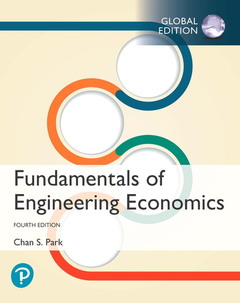Description
Fundamentals of Engineering Economics, Global Edition (4th Ed.)
Author: Park Chan
Language: English
Publication date: 07-2019
736 p. · 20.5x25 cm · Paperback
736 p. · 20.5x25 cm · Paperback
Description
/li>Contents
/li>Comment
/li>
For introductory engineering economics courses.
Chan Park, author of the best-selling Contemporary Engineering Economics, tells the story of engineering economy with the more concise Fundamentals of Engineering Economics by relating concepts from class to students? everyday lives. This book provides sound and comprehensive coverage of course concepts while addressing both the theoretical and the practical concerns of engineering economics. Written to appeal to a wide range of engineering disciplines, the text helps students build skills in making informed financial decisions and incorporates all critical decision-making tools, including the most contemporary, computer-oriented ones.
Chan Park, author of the best-selling Contemporary Engineering Economics, tells the story of engineering economy with the more concise Fundamentals of Engineering Economics by relating concepts from class to students? everyday lives. This book provides sound and comprehensive coverage of course concepts while addressing both the theoretical and the practical concerns of engineering economics. Written to appeal to a wide range of engineering disciplines, the text helps students build skills in making informed financial decisions and incorporates all critical decision-making tools, including the most contemporary, computer-oriented ones.
- PART 1 UNDERSTANDING MONEY AND ITS MANAGEMENT
- Chapter 1 Engineering Economic Decisions
- Chapter 2 Time Value of Money
- Chapter 3 Understanding Money Management
- Chapter 4 Equivalence Calculations under Inflation
- PART 2 EVALUATING BUSINESS AND ENGINEERING ASSETS
- Chapter 5 Present-Worth Analysis
- Chapter 6 Annual-Equivalence Analysis
- Chapter 7 Rate-of-Return Analysis
- Chapter 8 Benefit–Cost Analysis
- PART 3 DEVELOPMENT OF PROJECT CASH FLOWS
- Chapter 9 Accounting for Depreciation and Income Taxes
- Chapter 10 Project Cash-Flow Analysis
- Chapter 11 Handling Project Uncertainty
- PART 4 SPECIAL TOPICS IN ENGINEERING ECONOMIC
- Chapter 12 Replacement Decisions
- Chapter 13 Understanding Financial Statements
- Fundamentals is considered an alternative, more streamlined version of Contemporary Engineering Economics.
- Chan Park's renowned authoring style tells the story of engineering economics through engaging scenarios and his hallmark student-friendly writing style.
- A large number of end-of-chapter problems and exam-type questions varying in level of difficulty help students understand the topics.
- Appeals to the full range of engineering disciplines including industrial, civil, mechanical, electrical, computer, aerospace, chemical, and manufacturing engineering by providing real-world examples students can relate to in their everyday lives.
- All Chapter-opening vignettes have been updated and provide students with a real economic story describing how an individual decision maker or actual corporation has wrestled with the issues discussed in the chapter. These opening cases heighten students’ interest by pointing out the real-world relevance and applicability of what might otherwise seem to be dry technical material.
- Satisfy the practical needs of the engineer toward making informed financial decisions
- Expanded-Self-Test questions, formatted in a style suitable for FE Exam review, are available for each chapter and their worked out solutions are provided in Appendix A.
- Updated-75% of the questions are new or updated.
- Students are guided to outline the correct approach to example problems through a Given, Find, Approach, and Comments process. This guidance is intended to stimulate curiosity and to look beyond the mechanics of problem solving to explore “what-if” issues, alternative solutions methods, and the interpretation of solutions.
- Incorporate all critical decision-making tools including computer-oriented ones
- Emphasis on Excel’s use and productivity enhancing benefits for complex project cash flow development and analysis. All Excel spreadsheets contain e
© 2024 LAVOISIER S.A.S.




